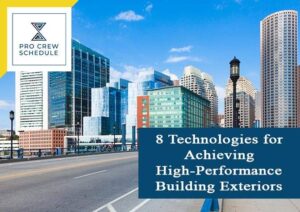Over the years, the construction industry has been moving from bulky, heavy masonry buildings with minimal roof insulation and limited fenestration to open and light-weight buildings with tons of glass and insulated roofs. In the present time, building enclosures consist of various products, each intended to serve a specific singular function and sometimes proprietary installation requirements. Hence, the building enclosure has now become more complicated than ever to construct and design.
For field engineers and contractors, knowing and understanding the technology developments for building enclosures as well as specific considerations and benefits of these advancing technologies is a crucial step in making sure to select the right products for one particular building. They ought to push toward greater energy efficiency despite being challenged with the actuality of aging infrastructure.
Here are the eight technologies that can help you in achieving and maintaining high-performance building exteriors.
1. Window and glazing
The present, market-driven design trends mandate large areas of fenestration to make an ideal space for building occupants. Today, buildings with huge glazing areas are now offering a significant and better thermal performance compared to highly-glazed buildings. The latter has been constructed some decades ago, where monolithic glazing and solid metal frames are used.
Moreover, energy-efficient improvements for fenestration systems include:
- Insulating glass units (IGUs).
- Thermally broken frames.
- Suspended film glass.
- Double glazed wall system.
- Triple-pane glass.
Thermal break technology has many improvements over the years. As a result, the materials get stringer and are more prepared to accept larger IGUs and triple-pane glass.
- Improvements in IGU technologies with thin films and low-e coatings help minimize solar heat gain.
- Self-shading glass automates the whole process for lessening glare and solar heat gain. Thus, increasing comfort for the users.
- Integrating daylight controls is further limiting energy use.
However, the particular trend to provide huge areas of penetration usually runs counter to changes. As a result, there are changes in the model building codes, affecting large grazing areas for building enclosures. Changes are hard to deal with but using construction scheduling software, and builders can quickly point out what’s wrong and what’s needed to improve—finding solutions become easier when using such advanced software.
2. Blue Roofs
A new roofing system called blue roofs attenuate stormwater flow from the roofs to support the existing antiquated infrastructure’s limited capacity. This type of roof also manages storm runoff, particularly in highly developed areas. Additionally, it controls more recurrent high-intensity storms resulting from climate change. Blue roofs can always be designed as an inverted roof membrane assembly or conventional roofing systems.
These systems store and gradually release precipitation for the time being. To obtain a well-performing and functional blue roof, roofers are challenged to identify the well-suited approach for every project’s specific needs. Below are three types of blue roofs.
- No-slope systems – has a greater storage capacity
- Low-slope roofs – has potentially more insufficient storage capacity.
- High-slope roofs – has check dams to improve the capacity further and to facilitates drainage.
3. Cool Roofs
Over the years, most roof surfaces are covered with dark-colored or black roofing membrane, given the sturdiness of asphalt and tar in traditional roofing materials. However, dark-colored roof surfaces tend to increase in temperature when being exposed to the sun. Therefore, the higher the surface temperature, the more increasing the roof system’s heat gain. As a result, it reduces the roofing system’s energy efficiency and raises cooling loads.
To address the inefficiency, the roofing industry must evolve to include minimal or light-colored roofing membranes. This type of membrane tends to reflect the sun’s rays and can absorb lesser heat and remain cool compared to its predecessors.
4. Water-resistant barriers
Current building codes are particular in designs for enclosure systems. It should include vapor retarders, waterproofing, air barriers, all of which have a tremendous impact on energy efficiency and durability. The waterproofing will prevent liquid, bulk water from infiltrating the building interiors. On the other hand, both the vapor retarder and air barrier avoid vapor water migration and affect various transport mechanisms.
Vapor retarders play a role by preventing the diffusion of water vapor through materials. The air barriers focus more on avoiding vapor migration via bulk air transport. The air barriers have an immediate impact on energy consumption.
5. Cladding attachments and insulation
Cladding attachment systems that are thermally-broken include critical thermal breaks. These systems are relatively new to the expanding market and do not have any significant track record of any long-term performance. In some systems, the insulation will be replacing the sheathing that is installed over cold-formed metal framing. While passing testing during installation, the systems are susceptible to air leakage and water unless installed correctly.
With insulation and cladding attachments, it is easy to simplify exterior wall systems and minimize cost without potentially compromising the performance.
6. Snow and ice protection
For the past years, the number of reported snow and ice cases falling from façades of new buildings has been increasing. This concern has become apparent on city streets during cold climates shortly after the snow—several questions whether the increase in those events correlates to the rise in high-performing new buildings.
Currently, the industry is continuously researching this particular question. Given the potential hazard and public attention that this significant issue used to present, it becomes a priority to understand the underlying causes and possible solutions more. The issue is too complicated by the increasing number of variables, affecting the potential for falling ice and snow.
Additional design guidance must be expected as this issue continues to challenge the industry for many years to come. That is why owners, contractors, and building designers must review the designs with more specific considerations. Doing so will incorporate protection, retention, and melting systems where the hazards are incredibly high.
7. Green Walls
Green walls are adopted on many buildings as designers and builders use vegetation specifically on vertical surfaces. Traditionally, green walls were entirely limited to ivy masonry buildings, leading to masonry damage over time. Today, less aggressive plantings are allowed to be established to provide green cover and help minimize rainwater running off down the walls.
It also assists with cooling, particularly on direct sun elevations, and usually provides a better and pleasing aesthetic. Cladding systems are designed to enhance durability, especially for vegetation, supporting structures to separate the cladding and planting.
8. Green Roofs
Planting vegetation over any occupied space has been quite common in the industry over the years. By 2004, Chicago became the very first city to mandate supportable features on buildings. It immediately resulted in a green roof phenomenon throughout the city. Today, the trend isn’t any more limited to Chicago because green roofs are now becoming very common in the U.S. and even worldwide.
Green roofs are a very efficient way to reduce cooling and heating loads, control stormwater runoff, and provide better opportunities for building occupants’ leisure and enjoyment. These roofs are proven to be more reliable, less expensive, and, therefore, more likely to be integrated into projects.
Why is Adopting Project Management Software Crucial to the Project’s Success?
Today, there are many emerging industry trends, a software application designed for construction project management. If you’re the project leader, you will soon discover that construction projects are way more complicated to handle because of the complexities. There are multiple and different things to keep track of that can sometimes be a potential nightmare.
In such circumstances, cloud-based software would fare much better and help contractors manage the different components more efficiently in the long run. This online tool can help construction professionals create a much more organized list of deliverables and tasks, making the project a success in time.
Here are several advantages of this software:
- Targets are clear and achievable – project planning becomes realistic and helps shape a much precise and clear timeline.
- Efficient project management for construction – The software’s general purpose is to make project management much better. Hence, every aspect of the project is best outlined, planned, and managed using this application.
- Time-tracking – tracking time and labor hours is one of the best features this software provides. Project leaders experience an easier way of monitoring all crew members.
- Real-time collaboration and communication – the application serves as a centralized medium for every single member. Thus, it is easy to reach out and to talk about any work-related matters.
- Cloud-based storage – all project files and construction data are stored in this advanced application. Whenever managing construction projects, there’s nothing to worry about the files getting lost.
- Accessible anytime and anywhere – since the application is cloud-based, it is easy to access at any place and anytime for as long as there’s a strong Internet connection.
- User-friendly – the app is very user-friendly with easy navigation as you explore all the features. Old workers and crew members can understand how each feature works.
Pro Crew Schedule is up in the market and still the best construction management software. You can request a live demo, and it is FREE!
Key Takeaways
To develop energy-efficient and high-quality building enclosures, you need to embrace technological advances for enclosure designs and materials. But to reap the benefits of these technologies without compromising project budget and durability, the project team should understand the intended use, limits, and potential for unexpected results.







